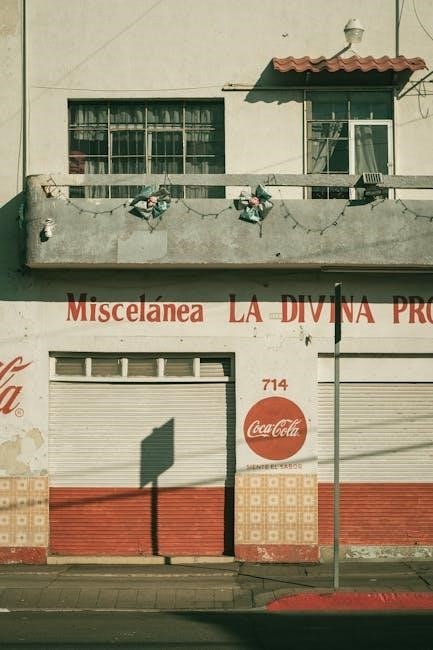The Coronilla de la Divina Misericordia, or Divine Mercy Chaplet, is a Catholic devotion reflecting on God’s mercy. Prayed using a rosary, it consists of 62 prayers focusing on forgiveness and divine grace.
Overview of the Divine Mercy Chaplet
The Divine Mercy Chaplet is a Catholic devotion that forms part of the Coronilla de la Divina Misericordia. It is a simple yet profound prayer recited using a standard rosary, consisting of 62 prayers that focus on God’s infinite mercy and grace. The chaplet begins with the Our Father and Hail Mary, followed by the Divine Mercy prayer repeated ten times. This prayer, rooted in Catholic tradition, is often recited for the forgiveness of sins, the conversion of souls, and the salvation of the world. Its structure is designed to be accessible to all, making it a popular devotion in the Catholic Church. The chaplet is typically prayed during specific times, such as Good Friday, and is deeply connected to the Easter season, emphasizing the resurrection and divine mercy. Its simplicity and universality have made it a beloved practice for millions of Catholics worldwide.
Purpose and Significance of the Coronilla
The Coronilla de la Divina Misericordia holds profound spiritual significance as a devotion centered on the mercy of God. Its primary purpose is to seek forgiveness for oneself and others, while also imploring divine grace for the conversion of souls. Rooted in Catholic theology, this chaplet emphasizes the boundless compassion of God, particularly through the sacrifice of Jesus Christ. It serves as a powerful tool for personal reflection and communal prayer, fostering a deeper connection with the Holy Trinity. The prayers within the Coronilla are designed to inspire hope and trust in God’s mercy, offering solace to those experiencing spiritual or emotional turmoil. By reciting the chaplet, believers participate in the redemptive mission of Christ, aligning themselves with His teachings of love and forgiveness. Its significance extends beyond personal devotion, as it is often used in liturgical settings during Lent and Easter, reinforcing the Church’s emphasis on mercy and reconciliation.

History and Origins of the Coronilla
The Coronilla de la Divina Misericordia originated in the 1930s through Saint Faustina Kowalska, a Polish nun who received visions from Jesus. He revealed the chaplet as a prayer for divine mercy and forgiveness, which later became a global devotion.
The Role of Saint Faustina Kowalska
Saint Faustina Kowalska, a Polish nun, is the visionary behind the Coronilla de la Divina Misericordia. In the 1930s, she received divine revelations from Jesus, who entrusted her with spreading the message of His mercy. Through her mystical experiences, Faustina recorded the prayers and structure of the chaplet, emphasizing its role in seeking forgiveness and trusting in God’s compassion. Her diary, Divine Mercy in My Soul, became the foundational text for the devotion. Faustina’s mission was to share the Divine Mercy message worldwide, and her efforts led to the chaplet’s popularity. Her canonization as a saint in 2000 further solidified her role as the apostle of divine mercy, inspiring millions to pray the Coronilla for spiritual renewal and peace.
Divine Revelation and the Birth of the Chaplet
The Coronilla de la Divina Misericordia originated from divine revelations received by Saint Faustina Kowalska in the 1930s. During her prayers, Jesus appeared to her, requesting a special devotion to His mercy. He provided the prayers and structure of the chaplet, emphasizing its purpose to seek forgiveness and trust in His compassion. Faustina documented these revelations in her diary, which became the blueprint for the chaplet. The divine message highlighted the importance of praying for mercy, especially for sinners and the dying, and the chaplet was to be recited using a rosary. This revelation marked the birth of the Coronilla, a powerful prayer tool for spiritual renewal and peace, reflecting God’s infinite mercy and love for humanity.

Structure of the Coronilla de la Divina Misericordia
The Coronilla de la Divina Misericordia is prayed using a standard rosary, incorporating specific prayers and a sequence that emphasizes divine mercy. It includes the Our Father, Hail Mary, Chaplet of Mercy, and Closing Prayer, reflecting its devotional structure.
The Use of the Rosary in the Chaplet
The Coronilla de la Divina Misericordia utilizes a standard rosary, adapting its structure for a devotion centered on divine mercy. While traditionally, rosaries focus on mysteries of the faith, the Chaplet replaces these with prayers emphasizing forgiveness and grace. The rosary’s beads guide the recitation of specific prayers, such as the Our Father, Hail Mary, and the unique Chaplet of Mercy, creating a meditation on God’s compassion. This use of the rosary aligns the Chaplet with familiar Catholic devotional practices, making it accessible and deeply rooted in tradition. The rosary’s tactile nature enhances the prayer experience, helping devotees focus on the spiritual themes of mercy and redemption. By incorporating the rosary, the Chaplet seamlessly integrates into Catholic prayer life, offering a structured yet personal way to reflect on divine mercy. This blend of tradition and innovation makes the Coronilla a powerful tool for spiritual reflection and devotion. The rosary’s familiar rhythm provides a comforting framework for those seeking to deepen their faith and connection to God’s mercy.
Prayers and Their Sequence
The Coronilla de la Divina Misericordia is a structured prayer that follows a specific sequence of devotions. It begins with the Our Father, Hail Mary, and the Creed, followed by the Chaplet of Mercy, which includes repeated prayers invoking divine mercy. The chaplet consists of 62 prayers, each focusing on a different attribute of God’s mercy. These prayers are recited on the beads of a rosary, with specific intentions for each decade. The sequence concludes with additional prayers, such as the Eternal Father and the Holy God, which emphasize sacrifice and forgiveness. This structured approach ensures a deep reflection on divine mercy and its application in daily life. The prayers are often recited on significant days like Good Friday, aligning with the themes of redemption and grace. The sequence is designed to foster a profound connection with God’s mercy, making it a meaningful and impactful devotion for those who pray it. The clear order of prayers ensures a meditative and intentional experience, guiding the faithful through a journey of spiritual renewal and forgiveness.

Specific Prayers and Their Meanings
The Coronilla de la Divina Misericordia includes specific prayers that hold deep theological significance. The chaplet begins with the Our Father, Hail Mary, and the Creed, followed by the Eternal Father prayer, which offers the Body, Blood, Soul, and Divinity of Christ for the forgiveness of sins. This prayer emphasizes sacrifice and divine mercy. The Holy God prayer, repeated three times, expresses awe and reverence for God’s mercy. Another key prayer is the Agnus Dei, which invokes Christ as the Lamb of God who takes away sins. These prayers are intertwined with repetitions of “For the sake of His sorrowful Passion, have mercy on us and on the whole world,” a refrain that underscores the redemptive power of Christ’s suffering. Each prayer is designed to deepen devotion to God’s mercy and foster a spirit of forgiveness and compassion. The specific structure and wording of these prayers reflect their origins in the revelations of Saint Faustina Kowalska, who emphasized the infinite mercy of God.

Theological Significance of the Coronilla
The Coronilla de la Divina Misericordia embodies Catholic theology’s core emphasis on divine mercy and forgiveness. It reflects the infinite love of God, particularly through Christ’s redemptive sacrifice, and is deeply connected to the Holy Trinity.

Divine Mercy in Catholic Theology
Divine Mercy is a central tenet in Catholic theology, emphasizing God’s unconditional love and forgiveness. Rooted in scripture, it highlights Christ’s redemptive mission and His sacrifice for humanity’s sins. The Coronilla de la Divina Misericordia, as a devotion, mirrors this theological cornerstone by invoking mercy through prayer and reflection on Christ’s Passion. It underscores the belief that God’s mercy is infinite and available to all who seek it, fostering a spiritual response of trust and conversion. This doctrine is intricately tied to the sacraments, particularly reconciliation, and encourages believers to emulate divine mercy in their lives. The Chaplet serves as a powerful expression of this theological principle, offering a means to intercede for oneself and others, seeking divine pardon and grace.
The Role of Sacrifice and Forgiveness

The Coronilla de la Divina Misericordia profoundly emphasizes the roles of sacrifice and forgiveness. Rooted in Catholic theology, it reflects the belief that Christ’s ultimate sacrifice on the cross embodies divine mercy and the forgiveness of sins. The Chaplet invites believers to unite their sufferings with Christ’s Passion, offering them as a sacrifice for the salvation of souls. Forgiveness is central, as the prayers implore God’s mercy for oneself and others, seeking pardon and reconciliation. This devotion underscores the transformative power of sacrifice and the boundless nature of divine forgiveness, encouraging believers to embrace these virtues in their lives. Through its prayers, the Coronilla becomes a powerful means to seek and share God’s mercy, fostering a deeper understanding of redemption and spiritual renewal.
Connection to the Holy Trinity
The Coronilla de la Divina Misericordia deeply connects to the Holy Trinity, reflecting the Catholic belief in the Father, Son, and Holy Spirit. The Chaplet begins with the Sign of the Cross, invoking the Trinity, and its prayers emphasize divine mercy as a Trinitarian gift. The “Eternal Father” prayer highlights the Father’s role in offering Christ’s sacrifice for humanity’s sins. The “For the sake of His sorrowful Passion” prayer appeals to the Son, Jesus, who embodies mercy through His crucifixion. Additionally, the Chaplet’s focus on forgiveness and grace aligns with the Holy Spirit’s role in transforming hearts and leading souls to penance. This devotion, therefore, unites believers with the Trinitarian mystery, fostering a deeper reverence for the Father’s love, the Son’s redemption, and the Holy Spirit’s sanctifying grace.

How to Pray the Coronilla
Pray the Coronilla using a standard rosary. Begin with the Sign of the Cross, followed by the “Our Father” and “Hail Mary;” Recite the Chaplet’s specific prayers in sequence, focusing on divine mercy and forgiveness.
Step-by-Step Guide to Recitation
To pray the Coronilla de la Divina Misericordia, begin with the Sign of the Cross. Recite the “Our Father,” “Hail Mary,” and “I Believe in God” prayers. Next, pray the “Eternal Father” prayer on each bead, followed by “For the sake of His sorrowful Passion, have mercy on us and on the whole world.” After five decades, conclude with the “Holy God” prayer repeated three times. End with the final prayers, including the “Holy Trinity” and “Eternal God,” seeking divine mercy and forgiveness. This structured approach ensures a meaningful and devotion-filled recitation of the Chaplet.
Recommended Times for Prayer
The Coronilla de la Divina Misericordia is traditionally prayed at specific times to deepen its spiritual significance. The most recommended time is at 3:00 PM, known as the “Hour of Mercy,” which commemorates the moment of Jesus’ death on the cross. Many also pray it during Lent, especially on Good Friday, to reflect on Christ’s Passion and divine forgiveness. Additionally, it is often recited on Divine Mercy Sunday, a feast established by Saint John Paul II to honor God’s infinite mercy. Praying the chaplet at these times aligns with its roots in Catholic devotion and enhances the prayer’s efficacy. While it can be prayed at any time, these moments are particularly meaningful for seeking God’s mercy and grace. Regular recitation, especially during these periods, fosters a deeper connection to the divine and strengthens faith. The structured timing also encourages communal prayer, uniting believers worldwide in their devotion to God’s mercy.
Benefits of Regular Recitation
Regular recitation of the Coronilla de la Divina Misericordia offers profound spiritual benefits, fostering a deeper connection to God’s infinite mercy. By praying the chaplet, individuals seek forgiveness for their sins and those of others, trusting in God’s boundless compassion. It also serves as a powerful tool for spiritual growth, helping believers cultivate humility, trust, and gratitude. The chaplet’s emphasis on sacrifice and forgiveness encourages believers to embrace suffering as a means of intercession for others, aligning with Catholic teachings on redemptive suffering. Praying the Coronilla regularly brings a sense of peace and reassurance, especially during challenging times, as it reminds us of God’s loving presence. Furthermore, it strengthens faith and deepens devotion to the Divine Mercy, as revealed to Saint Faustina Kowalska. Many find that consistent prayer enhances their ability to forgive others and themselves, fostering a spirit of reconciliation. Ultimately, regular recitation of the Coronilla de la Divina Misericordia is a transformative practice that nurtures the soul and draws one closer to the heart of God.

Cultural and Devotional Impact
The Coronilla de la Divina Misericordia has become a globally embraced devotion, fostering a deeper understanding of God’s mercy. Its widespread popularity has made it a central part of Easter and Lenten observances, transcending cultural boundaries and uniting believers worldwide in prayer and reflection.
Popularity in the Catholic Church
The Coronilla de la Divina Misericordia has gained immense popularity within the Catholic Church, becoming a beloved devotion worldwide. Its simplicity and profound focus on God’s mercy resonate deeply with believers, making it a central prayer during Lent and Easter. Many parishes incorporate the Coronilla into their liturgical services, often preceding Mass or during special events. The Vatican News and broadcasts from churches like Saint Mary Catholic Church highlight its global reach. The chaplet’s structure, using a standard rosary, makes it accessible to millions familiar with traditional Catholic devotions. Its 62 prayers, each emphasizing divine forgiveness, have captivated the faithful, inspiring personal and communal reflection. The availability of the Coronilla in PDF formats, often in multiple languages, has further amplified its reach. This devotion has become a unifying force, bridging cultural and linguistic divides, and is widely recommended by Catholic leaders for spiritual enrichment and fostering a deeper connection to Christ’s mercy.
Role in Easter and Lenten Devotions
The Coronilla de la Divina Misericordia holds a profound significance during Lent and Easter, serving as a powerful devotion for reflection and spiritual renewal. It is often recited on Good Friday, aligning with the remembrance of Christ’s Passion and the outpouring of His mercy. The chaplet’s focus on forgiveness and divine grace makes it a fitting prayer during the Lenten season, as believers seek to deepen their faith and prepare for Easter. Many Catholics incorporate the Coronilla into their personal and communal devotions, using it as a tool for meditation on the mysteries of redemption. The prayer’s emphasis on mercy resonates deeply during this period of penance and renewal. Additionally, the availability of the Coronilla in PDF formats has made it easier for individuals and communities to access and recite the prayers, fostering a universal connection to the divine mercy celebrated during Easter. This devotion has become a meaningful tradition, bridging the sacred journey from Lent to Easter.
Artistic and Liturgical Representations
The Coronilla de la Divina Misericordia is deeply intertwined with artistic and liturgical expressions, reflecting its spiritual significance. The iconic image of the Divine Mercy, depicting Jesus with rays of light symbolizing His mercy, is often associated with the Chaplet. This image, promoted by Saint Faustina, is a central artistic representation used in prayer materials and devotional art. In liturgical settings, the Coronilla is frequently recited during special Masses and prayer services, especially on Divine Mercy Sunday. The rosary used for the Chaplet is sometimes adorned with symbols of mercy, such as the cross or the Divine Mercy image, enhancing its devotional appeal. Additionally, the prayers of the Coronilla are often accompanied by hymns and chants, enriching its liturgical expression. The availability of the Coronilla in PDF formats has further popularized its artistic and liturgical presence, offering visually designed guides that include prayers, images, and instructions. These resources have made the Chaplet accessible to a global audience, ensuring its enduring role in Catholic devotional life.

Downloading the Coronilla de la Divina Misericordia PDF
The Coronilla de la Divina Misericordia PDF is widely available online, with sources like Scribd and Facebook offering downloadable versions. These PDFs often include prayers, instructions, and images, making them accessible for personal or communal use.
Online Sources for the PDF
The Coronilla de la Divina Misericordia PDF can be easily found on various online platforms; Websites like Scribd and Facebook offer downloadable versions of the chaplet, often accompanied by Prayer guides and instructional materials. Additionally, religious organizations and Catholic websites, such as Vatican News and La Fe Católica, provide access to the PDF, ensuring widespread availability for devotees worldwide. These sources typically include the full text of the chaplet, prayers, and sometimes images or visual aids to enhance the devotion. Many of these PDFs are free to download, making them accessible to individuals and communities alike. They are particularly useful for those who wish to pray the Coronilla privately or lead group recitations. The availability of these resources reflects the chaplet’s global popularity and its enduring significance in Catholic spirituality.
Language Variations Available
The Coronilla de la Divina Misericordia PDF is available in multiple languages to cater to a global audience. The most common versions are in English and Spanish, with the Spanish version being the original and most widely distributed. Additionally, translations in Portuguese, Italian, and French are also accessible, ensuring that devotees from diverse linguistic backgrounds can engage with the devotion. Some websites, such as Vatican News and Scribd, offer these translations alongside the original text for comparative study. Furthermore, the chaplet is sometimes provided in bilingual formats, such as English-Spanish, to assist non-native speakers in understanding and reciting the prayers accurately. The availability of these language variations underscores the universal appeal of the Coronilla and its role in uniting Catholics worldwide in prayer. This inclusivity ensures that the message of divine mercy reaches people in their native tongues, fostering deeper spiritual connection and participation.
Guidelines for Printing and Distribution
Printing and distributing the Coronilla de la Divina Misericordia PDF requires adherence to specific guidelines to ensure respect for its sacred content. The PDF should be printed on high-quality paper to maintain readability and dignity, especially for communal use. It is recommended to use a standard font size and clear formatting to enhance accessibility for all devotees. When printing, include the entire text without alterations to preserve the integrity of the prayers and instructions. Distribution should be carried out with the intention of spreading devotion and not for commercial gain. Permission from the publisher or relevant religious authority is advised for large-scale distribution. Additionally, ensure that the PDF is shared in its original form, without adding or removing content. For digital sharing, respect copyright laws and provide proper attribution to the source. This ensures that the Coronilla remains a meaningful and reverent tool for spiritual growth.
